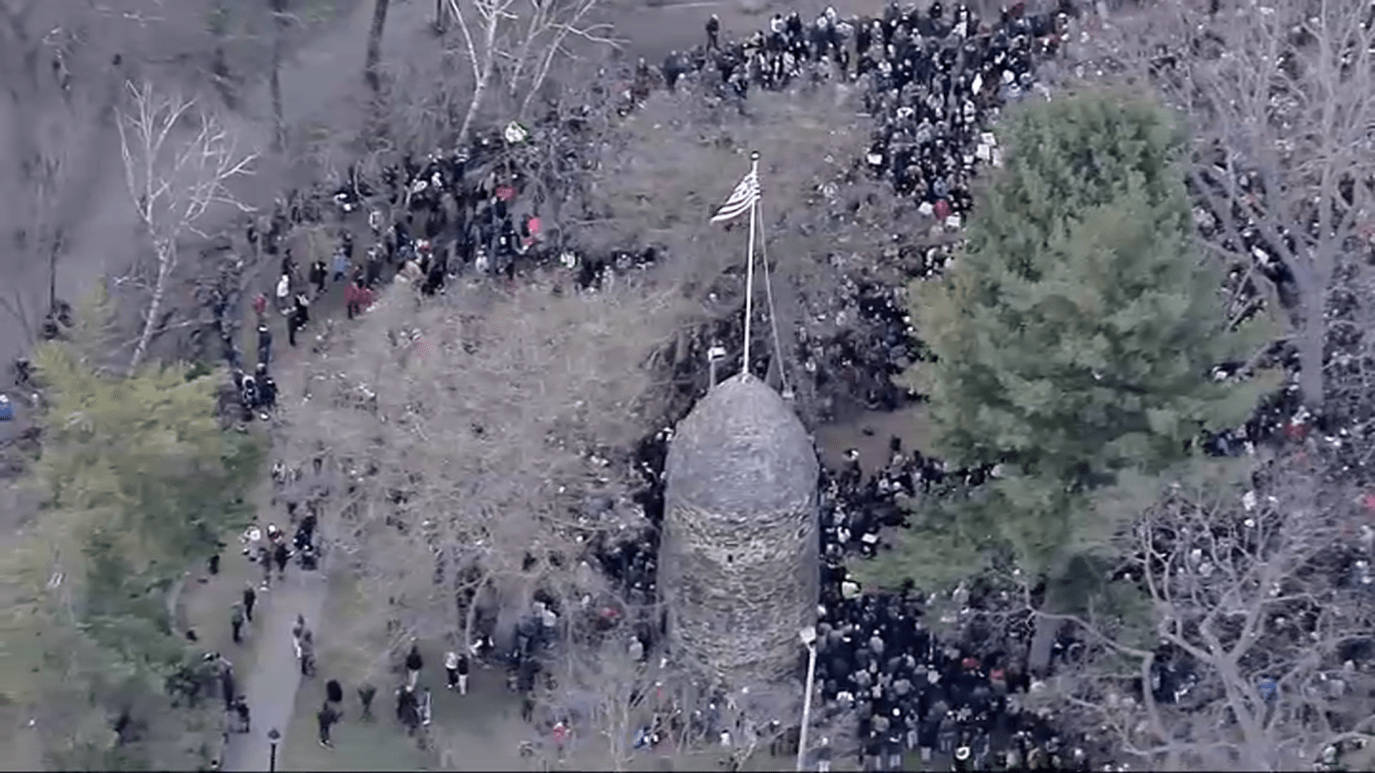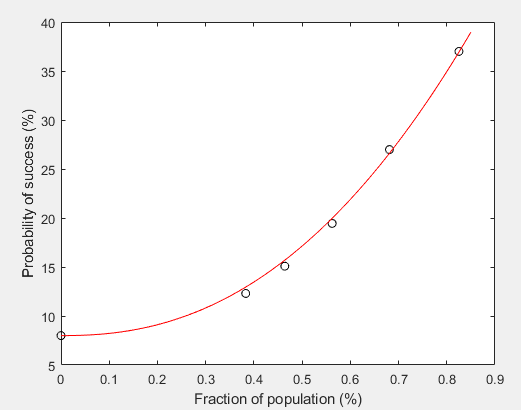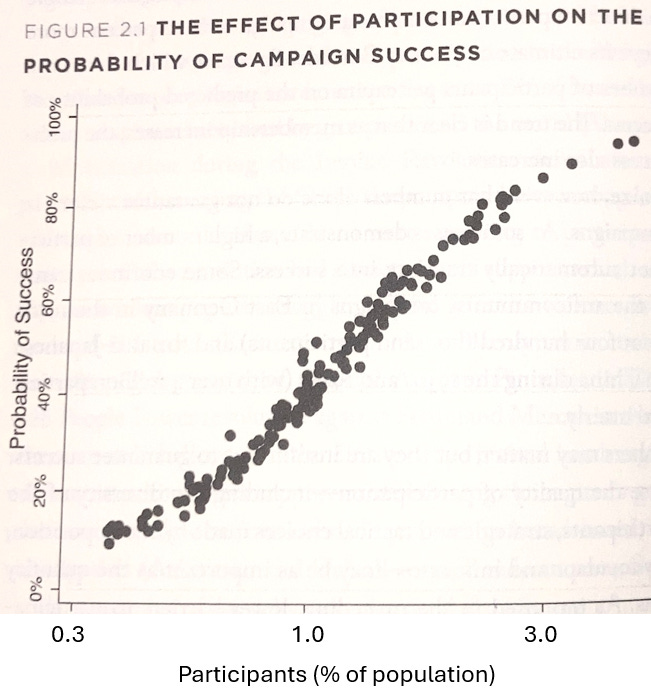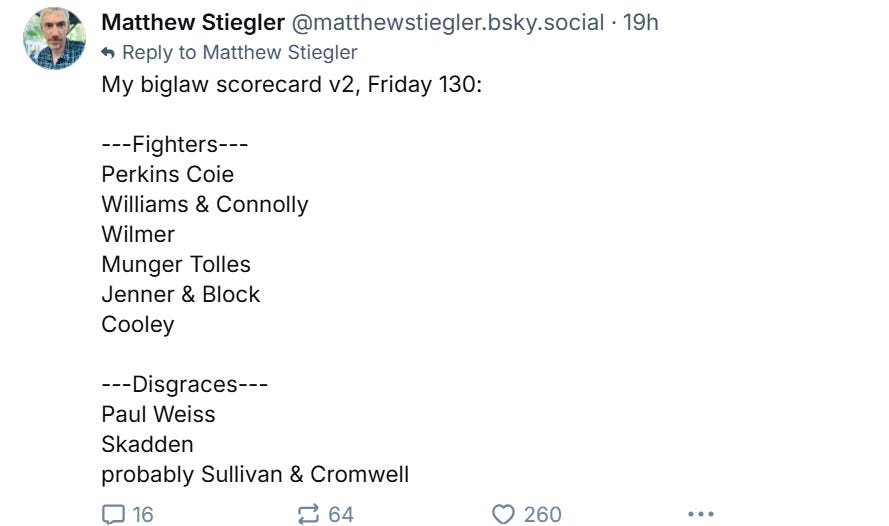Network effects of protest
10x the participants have 100x the effect
Happy Tesla Takedown Day, March 29, for those who celebrate!
Courage is contagious. After our university president Chris Eisgruber's call to stand up for the freedoms that we value, my colleagues and I responded with our own opinion piece in the student paper, the Daily Princetonian, attempting to mobilize our community. Will these signs of life grow?
This week, students at multiple schools are now being seized by ICE for their views. Students are responding with protests.

Full mobilization requires people to communicate with one another toward a common goal. For this reason, visible expressions of protest play an important role. You can contribute by your physical presence, and your amplification of messages through media.
Making moral behavior go viral
Last week I showed a graph of data from Erica Chenoweth and Maria Stephan. They showed that a nonviolent social movement became more likely to succeed as more people participated. Here's that graph again.
One can get into the details of what fraction of the population it takes to reach critical mass. But I think there’s another important point: this graph also captures the benefits of mutual cooperation.
Cooperation, virality, and multiplier effects
Their graph is plotted in logarithmic units, which I love as much as the next nerd, but let’s replot it in normal, linear units. Here it is:

Now something leaps out: this data has pronounced upward curvature, even as the fraction of participants increases linearly. This curvature has different names. In physics, we call it nonlinearity. In neurophysiology, we call it positive feedback. In technology development, we might call it a network effect. And in biochemistry, we would call this cooperativity. In all instances, the key concept is that the growth process goes beyond individual action. [1]
I have fitted the data with a curve that goes up approximately as the square of the fraction of participation [2]. Here is what that curve means:
If 10 times as many people participate, the effect is 100 times larger.
100 times as many people have 10,000 times the effect.
1,000 times as many people have 1,000,000 times the effect.
So each new participant has a larger and larger effect.
Increased participation makes a movement more visible, both to others and within the group. It is easier to build connections between participants. To make an analogy, this kind of cooperation helps make a diamond strong. Diamond is hard because of the aggregated effects of all the carbon-carbon bonds, crystallized. That's a cooperative effect.
Cooperativity and cooperation
In some sectors, a cooperative response is starting to develop.
Here at Princeton, colleagues in my department are petitioning our professional society, the Society for Neuroscience, to defend vulnerable scholars. We want them to take aggressive action to take aggressive action to protect our grants, as well as individual scholars whose liberties are at risk.
By itself, our letter is not enough. Our professional society runs on a “peacetime” basis. But we need, as Michael Corleone said in Godfather II, a wartime consigliere. To get that kind of leadership, colleagues at other schools can speak out - and help build a cooperative effect. (You can copy our letter, which is here, or adapt it for your own purposes.)
Because of the cooperativity effect, the second school to do so will produce four times the total effect of us acting alone. The third school will boost us to nine times the effect. And so on. And so on.
Who else will step up?
Such change may be brewing in other domains.
The big law community is under attack, with executive orders that attempt to take away security clearances as retribution for working on the Mueller probe. One firm, Paul Weiss, caved out of fear of losing business to the competition. Skadden, Arps may also capitulate, despite the individual courage of their junior associate Rachel Cohen. These are examples of isolated organizations that are taking an easy route out.
There are signs of courage as well. Perkins Coie has taken an aggressive stance against the attack, as has Jenner & Block. The latter case is being brought to the same judge, Beryl Howell. These firms and a few others recognize the extreme legal weakness of the executive order. Lord knows they have enough legal expertise to understand the absurd illegality of the executive order against them. Indeed, a judge has already issued a temporary restraining order in the Perkins case.
A pattern is developing. Under external attack, organizations can be divided and conquered, or they can rise to meet the external threat. Lawsuits get consolidated before the same judge, which is an example of a cooperative effect.
A big question in coming weeks and months is which institutions—not just schools and law firms, but also scientists, unions, Social Security recipients, federal employees, and more—will be able to mount a unified response to the the attack on civil society.
What you can do
A key component of amplification is the use of media: print, TV, or social. Liberal Currents gives a useful extended explanation of how people can use media to build a coherent story of protest.
You have social networks. Exert pressure, both in your community and to your professional organizations.
Go to local television and tell a story of how you are hurt. Write letters and opinion pieces to newspapers. Attend Tesla Takedown demonstrations and legislative town halls.
Climbing up that cooperative curve is hard at first, but every additional step gets makes a successively larger impact.
Today is Tesla Takedown day
Finally…today, Saturday March 29, is Tesla Takedown day. Attend a protest near you.
[1] I originally recognized the evidence of the network phenomenon by inspecting Chenoweth and Stephan’s curve, whose steepness is characteristic of cooperativity.
[2] The red curve is the function 8 + 45 p^k, where k=2.3. k=2 would be a square function.





Sam, I love the advocacy here; keep it up. But the Chenoweth and Stepan curve only approaches a quadratic over a narrow range -- instead of motivating people with "100X people = 10,000 X effect", it should be more about getting to the part of the curve where the gain is disproportionate.